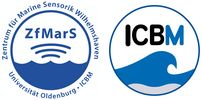PASSME
Air-Sea Gas Exchange: PArameterization of the Sea-Surface Microlayer (PassMe)
Duration: 5.5 Years (April 2014 until Setempber 2019)
The Earth’s ocean absorb about 30% of the anthropogenic carbon dioxide (CO2), and is, therefore, in the focus of the global carbon cycle. Therefore, a better understanding how the ocean absorbs CO2 is critical for the prediction of climate change. It is the primary objective of PassMe, which is funded by the European Research Council (ERC). Our earlier studies showed that much of the ocean is covered with natural surface films. These very thin films are enriched in organic compounds, which are derived from the microbial world in the ocean. Through the formation of a laminar, e.g. free of turbulence, boundary layer the films slow down the exchange of gases between the ocean and atmosphere, and additionally provide microbes a habitat. Under certain conditions biofilm-like habitats can be established at the sea surface, which likely affects the exchange of gases.
The research group Sea Surface designs an innovative research catamaran to allow both sampling thin layers from the sea-surface for subsequent analyses and, for the first time, “scanning” of the sea surface with in-situ sensors. Simultaneously, gas exchange rates of CO2 are assessed and related to environmental conditions and properties of the sea surface.

